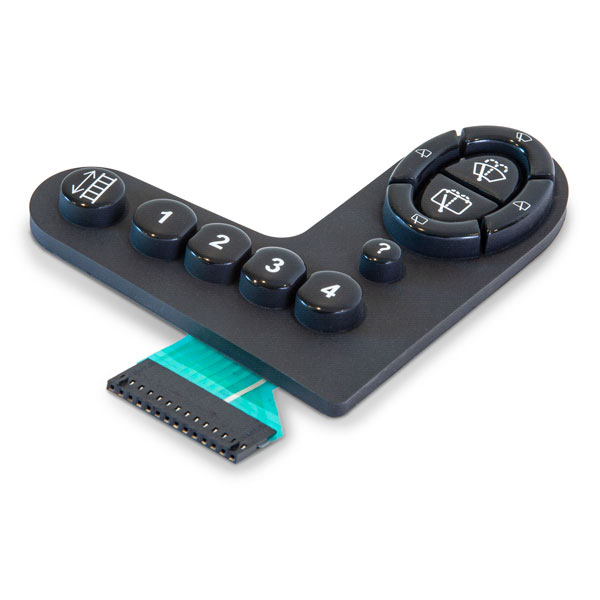Membrane Switch: Reliable, Cost-Effective, and User-Friendly Control Systems
Membrane Switch: Reliable, Cost-Effective, and User-Friendly Control Systems
Blog Article
Comprehending Membrane Layer Switches Over: The Key to Reliable and long lasting Controls

What Are Membrane Layer Buttons?
Membrane buttons are a sophisticated remedy in the realm of interface innovation, integrating performance and layout perfectly. These devices function as a user interface between customers and digital systems, integrating a number of elements right into a small layout. Usually built from adaptable, slim layers of products, membrane layer buttons are created to react to touch, making it possible for users to communicate with equipment and electronic tools efficiently.
The key elements of a membrane button include a published circuit layer, visuals overlay, and a spacer layer that avoids unintended activation. The graphic overlay can be tailored to reflect brand name identity or individual preferences, enhancing looks while making sure use. Membrane layer switches are typically used in different applications, including clinical tools, consumer electronic devices, and industrial equipment, owing to their longevity and resistance to environmental variables such as moisture and dirt.
One of the vital advantages of membrane layer switches is their ability to withstand deterioration, making them optimal for high-traffic atmospheres. Furthermore, they are light-weight and require minimal room, allowing for cutting-edge designs in product growth. On the whole, membrane layer changes stand for a functional and effective option for modern electronic user interfaces, marrying innovation with user-centric design concepts.
Just How Membrane Changes Work
The operation of membrane changes hinges on a straightforward yet effective system that equates individual input into electronic signals. When a user presses the button, the top layer flaws, allowing a conductive element in the circuit layer to make contact with a corresponding conductive pad on the bottom of the graphic overlay.
The design of membrane switches can vary, however they typically incorporate domes or responsive aspects to supply comments to the user, enhancing the total experience - membrane switch. The products used in membrane layer switches, such as polyester or polycarbonate, add to their resilience and resistance to environmental aspects, consisting of dampness and dirt. The printed circuits are commonly encapsulated, which shields them from wear and tear over time.
Benefits of Membrane Buttons

Furthermore, membrane buttons are understood for their resilience. Created from robust products, they are resistant to dirt, dampness, and physical wear, which significantly prolongs their life-span contrasted to conventional mechanical buttons. This longevity makes them specifically appropriate for high-traffic environments and applications calling for longevity.
Another significant benefit is the simplicity of cleansing get redirected here and upkeep. The smooth surface of membrane switches decreases dust build-up and is frequently resistant to navigate to this site spills, making them excellent for settings that call for constant sanitization.
Furthermore, membrane buttons provide a structured account, resulting in a thinner layout that can be integrated into different devices without adding mass. This attribute not only improves the visual appeal yet likewise contributes to an extra ergonomic item style.
Applications of Membrane Switches
Straightforward and flexible, membrane layer buttons discover applications across a wide variety of markets, consisting of medical gadgets, consumer electronics, and industrial equipment. In the clinical field, these buttons are integral to devices such as diagnostic equipment, individual surveillance systems, and mixture pumps, where reliability and convenience of cleaning are critical. Their ability to withstand severe settings and preserve functionality makes them perfect for such applications.

In customer electronic devices, membrane layer buttons are utilized in items like microwaves, cleaning devices, and remotes - membrane switch. Their smooth layout permits instinctive individual interfaces, boosting the general customer experience while giving toughness and resistance to tear and wear
Industrial tools likewise gains from membrane layer switches, especially in control panels for equipment and automation systems. These switches provide protection versus dirt and dampness, making certain regular performance in challenging environments. Their adjustable functions permit producers to customize them to particular operational requirements, enhancing performance and capability.
Selecting the Right Membrane Layer Switch
When selecting a membrane button, it is necessary to consider various variables that influence performance and suitability for certain applications. The key considerations consist of environmental conditions, responsive feedback, toughness, and style specs.
First, analyze the operating setting; buttons revealed to moisture, chemicals, or severe temperature levels need details materials to make certain durability and performance. Next, assess the demand for tactile responses. Depending on customer communication, some applications may take advantage of a tactile feedback to verify activation, while others may like a non-tactile style for aesthetic factors.
Toughness is another critical factor; membrane buttons need to be designed to hold up against frequent use, impacts, and abrasion. Make sure the selected button can endure the expected lifecycle, especially in high-usage scenarios.

Final Thought
In verdict, membrane layer changes serve as crucial parts in the layout of resilient and trusted control systems throughout various sectors. The versatility of membrane layer changes allows for tailored services that satisfy certain functional requirements, enhancing their value blog here in modern-day innovation.
Membrane layer switches over stand for an essential facet of modern user interface style, blending functionality with resilience in different applications.Membrane layer switches are an innovative remedy in the world of individual interface technology, incorporating performance and design perfectly. Usually constructed from versatile, slim layers of materials, membrane layer switches are created to respond to touch, allowing users to interact with machinery and electronic devices properly.
The design of membrane layer buttons can differ, but they commonly include domes or responsive aspects to give responses to the individual, enhancing the total experience.In final thought, membrane layer changes serve as important parts in the layout of trusted and durable control systems throughout different industries.
Report this page